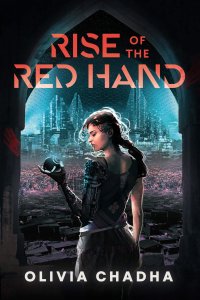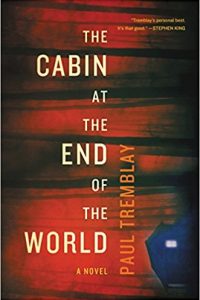Paul Di Filippo Reviews Rise of the Red Hand by Olivia Chadha
 Rise of the Red Hand, Olivia Chadha (Erewhon 978-1645660101, $18.95, 384pp, hardcover) January 2021.
Rise of the Red Hand, Olivia Chadha (Erewhon 978-1645660101, $18.95, 384pp, hardcover) January 2021.
Olivia Chadha’s heartfelt, adroit, brisk and thoughtful debut novel proves that everything old is new again. While its “Clutian Real Year” (i.e., the headspace and zeitgeist that birthed it and which provided its themes) is definitely 2020, its soul and blood and sinews are somewhere back in 1985, with the nascent Neuromancer. It’s nth-generation cyberpunk, with all of that mode’s glistening surfaces, rotting underbelly, streetlife tech and callous unethical Powers That Be. It’s wonderful and amazing and somewhat delightful how that flavor of SF, now some 35 years old, remains powerful and useful and potent, infinitely adaptable to new realities and able to shine its laser light on old-new inequities and iniquities. Of course, it also remains sexy and captivating on a narrative, SFX level. The pioneers of this subgenre built well.
Let’s contemplate Chadha’s worldbuilding first, before focusing on characters and action.
At some point in our future, World War III broke out, fought with giant mechas and, finally, with good old-fashioned nukes that devastated much of the planet’s surface and biosphere, and brought on a partial nuclear winter. Now, a few decades later, the world is somewhat stable again, thanks to the Planetary Alliance Commission, PAC. They oversee the various reconstituted polities, one of which, the South Asian Province, is our venue. Here rises Central City, a redoubt of privilege and safety and good health, aided by the computer mind (not fully sentient) dubbed Solace. Residents of Central City are able to jack into Solace’s cyberspace thanks to their implants.
Clustered down at sea level around Central City is the Narrows, a ghetto hive of the outcast and poor and sick and unfortunate third-class citizens, subject to the surveillance state above them. All that supports and uplifts the beleaguered citizenry is the Red Hand, a semi-secret organization. One wing of the group performs charitable works and serves as a quasi-civic government, while another wing plots revolution and overthrow.
So much for the backstory.
We dive right into the action with one of our three viewpoint characters, Ashiva. We find her corralled by the authorities, along with some other miscreants, and riding in a paddy wagon to some horrid fate. Then with this mystery still looming, we jump back five extremely fraught days into the past and begin to learn more.
Ashiva is a runner-cum-smuggler-cum-courier for the Red Hand. Her exemplary brave and bold and smart actions have earned her a place in their councils. She’s a cyborg, as are many of the castoff citizens, patched up by the rogue doctors of the Narrows, among whom a woman named Masiji is paramount. Ashiva has a network of colorful friends and comrades, most vital of whom is her adopted sister, Taru. Taru will become our second narrator in alternate installments, and she proves herself equally competent as a rebel, albeit of a differing temperament from her sister.
Meanwhile, up in Central City, Riz-Ali, expert teen hacker and son of the mighty Communications Minister, our third voice, chafes at his well-off existence. He undertakes a virtual mission for the Red Hand, and thereby sets off his own undoing. When the rulers of the SAP decide that the Narrows has outlived its usefulness and all its residents must be forcibly relocated, Ashiva, Riz-Ali, and Taru, along with a sterling allotment of subsidiary folks, will have to fight anew for a place in the world.
Chadha’s prose and stylings are not particularly noir, as with echt Gibson. She deploys a lucid, unornamented voice that serves her purposes well, showing us the grimness of existence, but also granting clear access to the inner lives of her protagonists. Her characters are all defiant fighters, unwilling to bow to their “superiors.” Ashiva grows from mere smuggler to burgeoning tactical wizard, while the path walked by Riz-Ali is very dramatic and shocking. Secrets behind the seemingly beneficent Masiji contour her nature with a series of revelations. A slow-burning relationship between Ashiva and Riz-Ali is charming, and of course the sisterly bond with Taru is well portrayed.
I won’t claim that Chadha introduces any startling new cyberpunk tropes. Even certain names—Ashiva is called the “Chrome Tiger,” while Riz is “Kid Synch”—might have come straight from some Reagan-era SF classic. But her swell utilization of the c-p toolkit is beyond reproach. Additionally, seasonings of Richard Morgan, Ian McDonald, and Paolo Bacigalupi contribute nice elements to the mix.
Add in “Real Year” bits like a pandemic and the nature of one-percenter privilege under quasi-authoritarian rule (is Central City really our 2020 Singapore?), and you have a stimulating cocktail.
Chadha also shows herself to have a gift for depicting propulsive action. A climactic battle between Ashiva and a mecha C.O.R.E. soldier will get your blood racing. And the surprising ending, totally satisfactory, is a good launch platform for what’s to come.
Billed as “Book One of the Mechanists”, Rise of the Red Hand proves itself willing to shatter daringly all its initial assumptions and verities, putting its cast through life-altering fires, in order to create new forms of beauty and hope and possible salvation.
 While you are here, please take a moment to support Locus with a one-time or recurring donation. We rely on reader donations to keep the magazine and site going, and would like to keep the site paywall free, but WE NEED YOUR FINANCIAL SUPPORT to continue quality coverage of the science fiction and fantasy field.
While you are here, please take a moment to support Locus with a one-time or recurring donation. We rely on reader donations to keep the magazine and site going, and would like to keep the site paywall free, but WE NEED YOUR FINANCIAL SUPPORT to continue quality coverage of the science fiction and fantasy field.
©Locus Magazine. Copyrighted material may not be republished without permission of LSFF.







